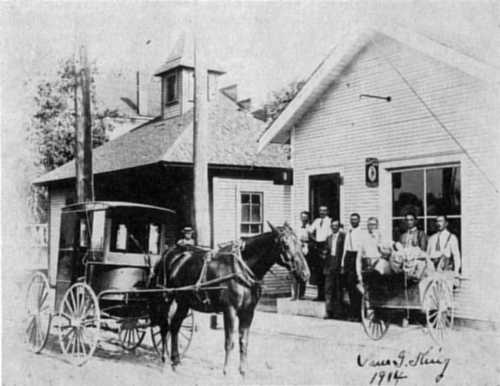|
Chapter Three
Canal creates rivalry Work on the Central Canal from 1836 to 1839 brought many people into the Broad Ripple-Wellington area, and as a result, business began to develop and grow. In 1843, John Burke, the canal contractor, built a saw mill just below the Broad Ripple feeder dam. Two years later, Peter W. Koontz became his partner, and the two men operated the saw mill and also built a grist mill. As early as 1836, Robert Earl opened a variety store in Broad Ripple. He later sold the store to Zachariah Collins in the 1840's. From that time on the store changed ownership many times. It was finally purchased by Joseph Wray who also built a dwelling, a grocery store, and a saloon on the west side of the dam. In Wellington, the dry goods business was started when William Switzer opened a store in 1839. The business was later sold to Reed Hardin, and then to Gordon C. Johnson, who in turn sold it to Swartz Mustard. Competition arose when Jackson Dawson opened the second dry goods store. Intense rivalry developed between the villages of Broad Ripple and Wellington over the control of the Central Canal and the domination of the canal area. Settlers in Wellington, on the south side of the canal, thought of Broad Ripple, on the north side, as a meeting place of crude and common people. For even before the canal was completed in 1839, the Broad Ripple saloon was often crowded with canal workers. Broad Ripple citizens, in turn, regarded Wellington as "Hell's Half Acre". Perhaps the best example of the rivalry involved what is now the Broad Ripple Post Office. The office was opened in 1850, with William Earl as the first postmaster. Because of political whims, the post office was moved shortly thereafter to Wellington, but not permanently, for it was soon moved back to Ripple. Then, for several years it switched locations from Broad Ripple to Wellington and back again. Finally, in 1884, the Post Office Department settled the matter by locating the post office in Wellington, but retaining the name of Broad Ripple. After that, Wellington gradually lost its identity, and the two villages eventually became one. Physicians have played an important part in the life of both settlements. Broad Ripple's first physician was Dr. Harvey Kerr, who practiced from 1851-1880. Dr. Robert C. Light practiced from 1884 until the turn of the century. The first physician in Wellington was Dr. Joseph Alter. He was succeeded by Dr. Horatio Johnson and later by Dr. Edward Collins.
Doctors were often called upon to make visits across the canal, and in so doing, had to hold lanterns for their horses to find their way.
Once a doctor had to swim across the canal to get medicine for a young patient.

Contents
|
